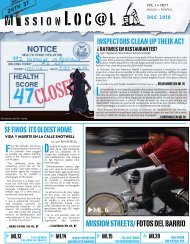Columbia Journalism sChool Winter 2010 - Berkeley Graduate ...
Columbia Journalism sChool Winter 2010 - Berkeley Graduate ...
Columbia Journalism sChool Winter 2010 - Berkeley Graduate ...
Create successful ePaper yourself
Turn your PDF publications into a flip-book with our unique Google optimized e-Paper software.
2<br />
<strong>Columbia</strong> <strong>Journalism</strong> <strong>sChool</strong> <strong>Winter</strong> <strong>2010</strong><br />
Nicholas Lemann<br />
Dean’s letter<br />
—<br />
We began the 2008–2009 academic year with an opening-day talk<br />
to the incoming Class of 2009 by Leonard Downie, Jr., who was<br />
just then stepping down after 17 years as executive editor of The<br />
Washington Post. Len spoke eloquently about his concern over<br />
the erosion of economic support for what he called “accountability<br />
journalism,” the core reportorial function of the press and what<br />
most of our students want to do in life. Afterwards, Len and I<br />
went up to my office to talk, and not long after we decided to produce<br />
a major report that would survey the landscape of accountability<br />
journalism and then suggest ways it might be supported in the<br />
future. Before long Michael Schudson, a distinguished scholar on<br />
our faculty, had signed on as co-author, and the Revson Foundation<br />
as lead funder.<br />
Not much more than a year later, in mid-October 2009, the Downie-Schudson<br />
report was published. It is called “The Reconstruction of American <strong>Journalism</strong>.”<br />
You can find a full text at www.journalism.columbia.edu/journalismreport.<br />
It represents the school’s single biggest effort, in the almost seven years I<br />
have been dean, to address a larger issue in our profession.<br />
The results have been highly gratifying. At a time when the air is thick with<br />
discussions on the future of journalism, our report stood out and gained<br />
an unusual degree of attention. There were hundreds of articles about it<br />
published all over the world — in most of the leading American publications,<br />
and as far away as France, Germany and Korea. Len and Michael have been<br />
constant and vigorous participants in discussions at the highest levels of the<br />
news business, the nonprofit sector, and government. In early February our<br />
friends at the Reuters Center in Oxford will hold a two-day conference on<br />
the report, which is meant to launch a follow-on effort for Europe, where<br />
journalism is having many of the same economic problems.<br />
It’s a sign of both the quality of the report and of the stature of the <strong>Journalism</strong><br />
School that it has had so much impact. We aren’t planning another report,<br />
but we are hoping to launch some new initiatives in <strong>2010</strong> that should maintain<br />
our central role in this all-important conversation. One, we hope, will<br />
be a follow-up to the report’s recommendation that journalism schools<br />
and their home universities find a way to be more significant producers of<br />
accountability journalism. Another will aim to generate a discussion of<br />
what’s happening in the economic market for journalism, especially digital<br />
journalism, that is as significant and helpful as the report’s discussion of<br />
public policy and journalism has been. Here’s hoping that in one of my next<br />
few dean’s letters, I will be able to report more fully on the start of these<br />
ventures.<br />
introducing:<br />
ColumBia<br />
JournaliSm<br />
SChool<br />
—<br />
By Michael Kubin ’05, Steve<br />
Wolgast ’92, and Andrew Pergam ’01<br />
Alumni Board Communications<br />
Subcommittee<br />
ThiS STory iS aBouT the magazine you’re<br />
holding, but let’s begin with a bit about<br />
breath mints. One participant in a Certs<br />
TV commercial would say, “It’s a breath<br />
mint!” while the other would argue, “It’s a<br />
candy mint!” The announcer then resolved<br />
the dilemma by explaining that Certs is<br />
“Two, two, two mints in one!”<br />
And so it is with <strong>Columbia</strong> <strong>Journalism</strong><br />
School: It’s both the School’s publication<br />
(formerly called 116th & Broadway) as well<br />
as the newspaper for graduates (which<br />
used to be the Alumni Journal). So it’s<br />
two, two, two publications in one.<br />
Your Alumni Board has been working<br />
on this project in conjunction with Irena<br />
Choi Stern ’01 and a professional magazine<br />
designer for over a year; our intention is for<br />
this new publication to serve our community<br />
more efficiently and effectively than before.<br />
Specifically, you will be receiving three<br />
issues per year, each with its own focus:<br />
Fall: Back to school — what’s new<br />
<strong>Winter</strong>: What’s happening now<br />
Spring: The year’s wrap-up, and looking ahead<br />
News about alumni will be included<br />
prominently in each issue in a dedicated<br />
section. The intention is for it to be a useful<br />
and informative publication for our community;<br />
to that end we solicit and welcome<br />
alumni contributions on School- and industry-<br />
related subjects. Current students are<br />
equally welcome to submit pieces for<br />
publication. As a reflection of the increasingly<br />
important role of the Internet,<br />
<strong>Columbia</strong> <strong>Journalism</strong> School will continue<br />
to appear online in its entirety. Its Web site<br />
(www.journalism.columbia.edu) will also<br />
be the place for you to look for breaking<br />
news. We sincerely hope you see this new<br />
publication as progress and we look forward<br />
to your comments and suggestions.



